2012 VOLKSWAGEN GOLF PLUS weight
[x] Cancel search: weightPage 110 of 541
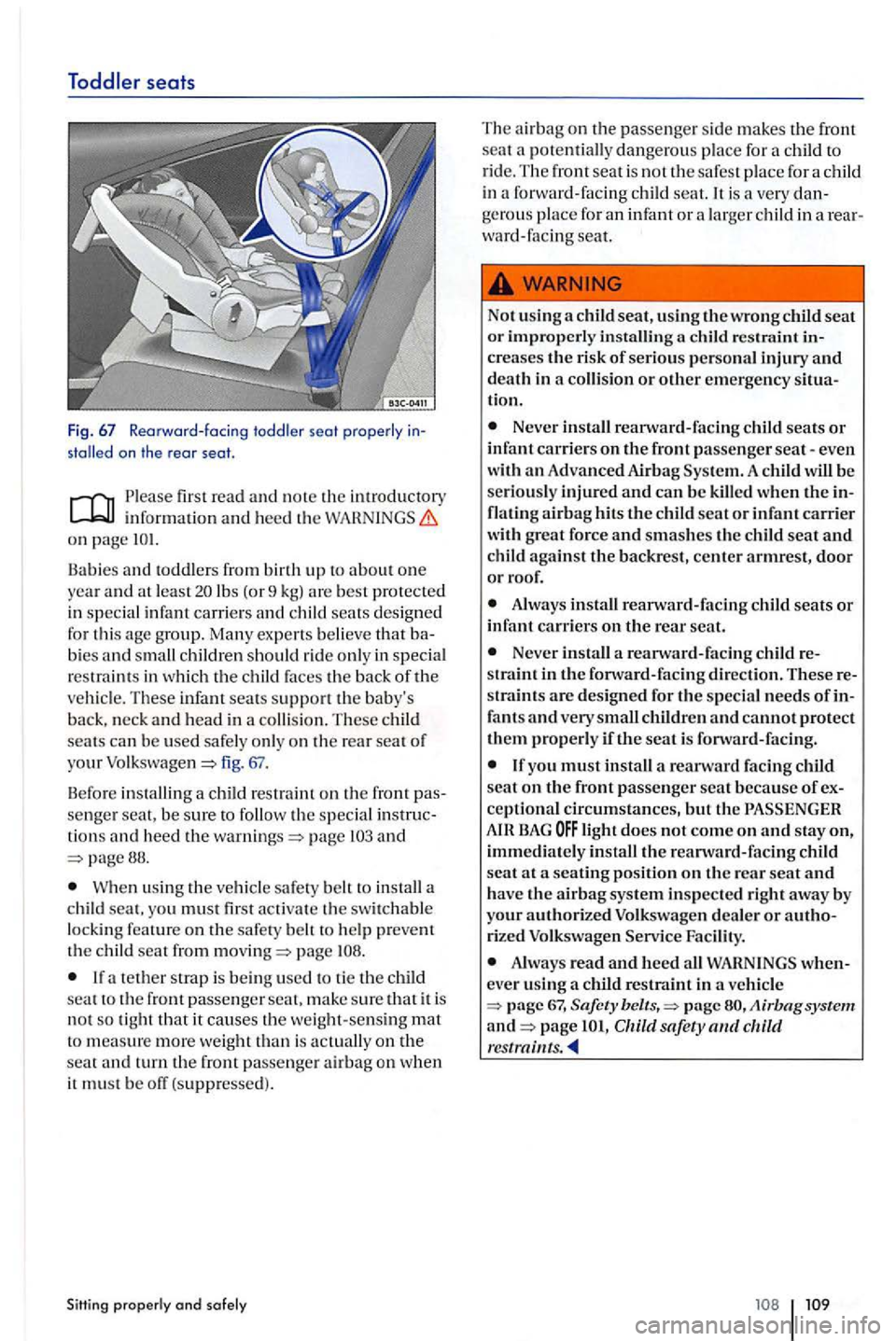
Please first read and note th e introductory information and heed the on pag e
Babies and toddlers from birth up to about one year and least lbs (or 9 kg) best protected
in spec ial infant carrier s and child seats designed
for this age group. Many experts believe that ba
bies and s mall children sh ould ride only in s pecial
r es traint s in which the child faces the back of the
ve hicl e. These infant seats support the bab y's
back, neck and head in a collision. These child
sea ts ca n b e use d safe ly on ly on th e rea r seat of your fig.
page and 88.
Whe n using the vehicle safety belt to install a
c hil d seat, you mu st fir st activate the switchable
lockin g fe ature on th e safe ty belt to help preve nt
th e c hild seat from pag e
tether strap is being used to tie th e child seat to th e front passenger mak e sure that it is not so tight that it causes the weight-sensing mat to measure more weight than is actu ally on the seat and turn the front passenger airbag on when it mu st b e (suppre ssed).
SiHing properly and safely
The airbag on th e passenger side make s the front
sea t a pot entially dangerou s pla ce fo r a child to
ride. The front seat is not the s afes t place for a child
in a forward-facing child seat.
is a very dange rou s place for an infant or a larger child in a rear
ward-fa cin g seat.
Not using a child seat, usi ng the wrong child seat or improperly installing in
creases the risk of serious personal injury and death in a collision or other emergency situa
tion.
Never install rearward-facing child seats or infant carriers on the front passenger seat-even
with an Advanced Airbag System. A child will be seriously injured and can be killed when the in
flating airbag hits the child seat or infant carrier
with great force and smashes the child seat and child against the backrest, center armrest, door or roof.
Always install rearward-facing child seats or infant carriers on the rear seat.
Never install a rearward-facing child re
s traint in the fonvard -facing direction. These re
s traint s are designed for the special needs of in
fants and very small children and cannot protect them prope rly if the seat is fonvard-facing.
you must install a reanvard facing child
seat on the front passenger seat because of ex
ceptiona l c ir cumstances, but th e BAG light does not come on and stay on, immediately install the reanvard-facing child seat at a seating position on the rear seat and have the airbag system inspected right away by your authorized Volkswagen dealer or authorized Volkswagen
Always read and heed all in a vehicle =>page 67, Safety belts,=> pag e page safety
Page 112 of 541
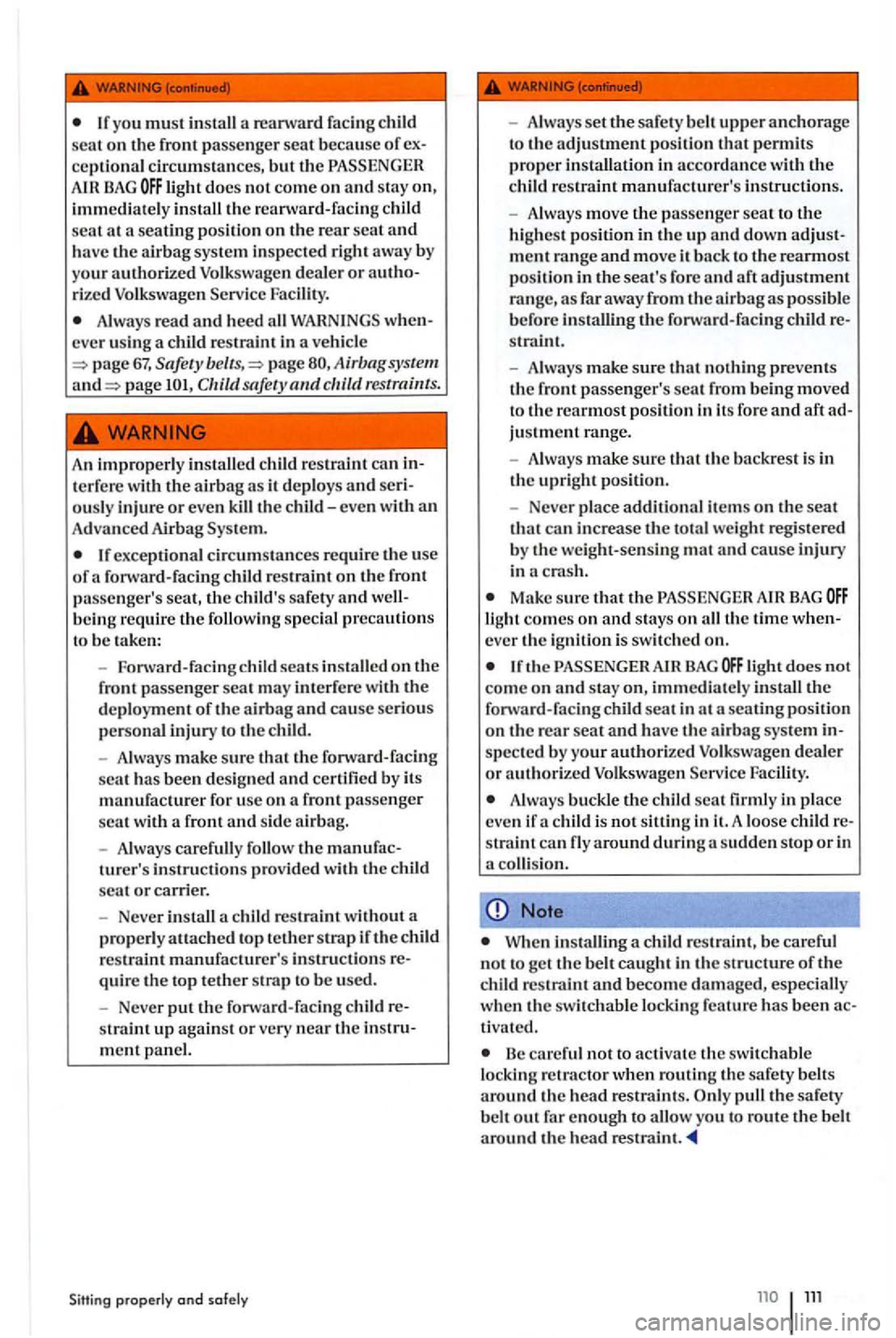
you must install a reanvard facing child
seat on th e front passe nger seat b eca use of ce pti ona l circumstances , but the light does not come on and stay
Facil ity.
Alway s read and heed all
page Safety pag e Airbn g sys te m page safety restraints.
An improperly installed child res traint can terfe re w it h th e airbag as it de plo ys and ously injure or even kill the child -eve n w ith an Advanced Airbag
being require the following sp ecia l precautions
to be tak en:
-
Fonvard-facing child seats in stalle d on the front passe nger seat may interfere with the de ploym ent of the airbag an d cause se riou s
p ersonal inju ry to th e c hild.
- Always make s
ure that the fonvard-facing seat has been des igned and certified by its manufacturer for use on a front passe nger seat wit h a front and sid e airbag.
- Always care full y follow the ture r's in struction s prov ided with the c hil d scat or carrier.
- Never install a child res traint w
ithout a properly attach e d top tether strap if the child
res traint manufacturer's instructions quire the top te th er strap to be u sed.
- Neve r
put the fonva rd-faci ng c hild straint up agains t o r very nea r the
properly and safely
- Always set the safe ty belt upper a n ch orage
t o th e adjustment positi on tl1at permit s proper in stallation in accordance with th e child restraint manufacture r' s in struction s.
- A
lways move the passenger seat to the
hi ghest position in the up and down
justment range.
- Always
make sure that th e backres t is in
th e upright position .
- Never place
additional items on the seat th at can increase the tota l we ight regi ste red by the weight-se nsing mat and cau se injury
in a c rash .
Mak e sure that the BAG
If the BAG OfF light does not com e on and sta y immediately in stall the fonvard -facing child seat in at a seatin g position on the rear seat and have the airbag sys te m
Fac ility.
Always buckle the c hild seat in place even if a child is not sitti ng in it. A loose child
collisio n.
Note
When installing a child res traint , b e ca reful
not to get the belt caught in tl1c structure of tl1e child res traint and become damaged, especia lly when the swi tc habl e lo ckin g feature has been tivated.
Be careful not to activa te th e sw itch a bl e
lo ckin g retra ctor when routin g th e safety belt s
a round the head restraints . p ull the safety
b elt out far enough to allow you to route tl1e belt around th e head restraint.
Page 115 of 541
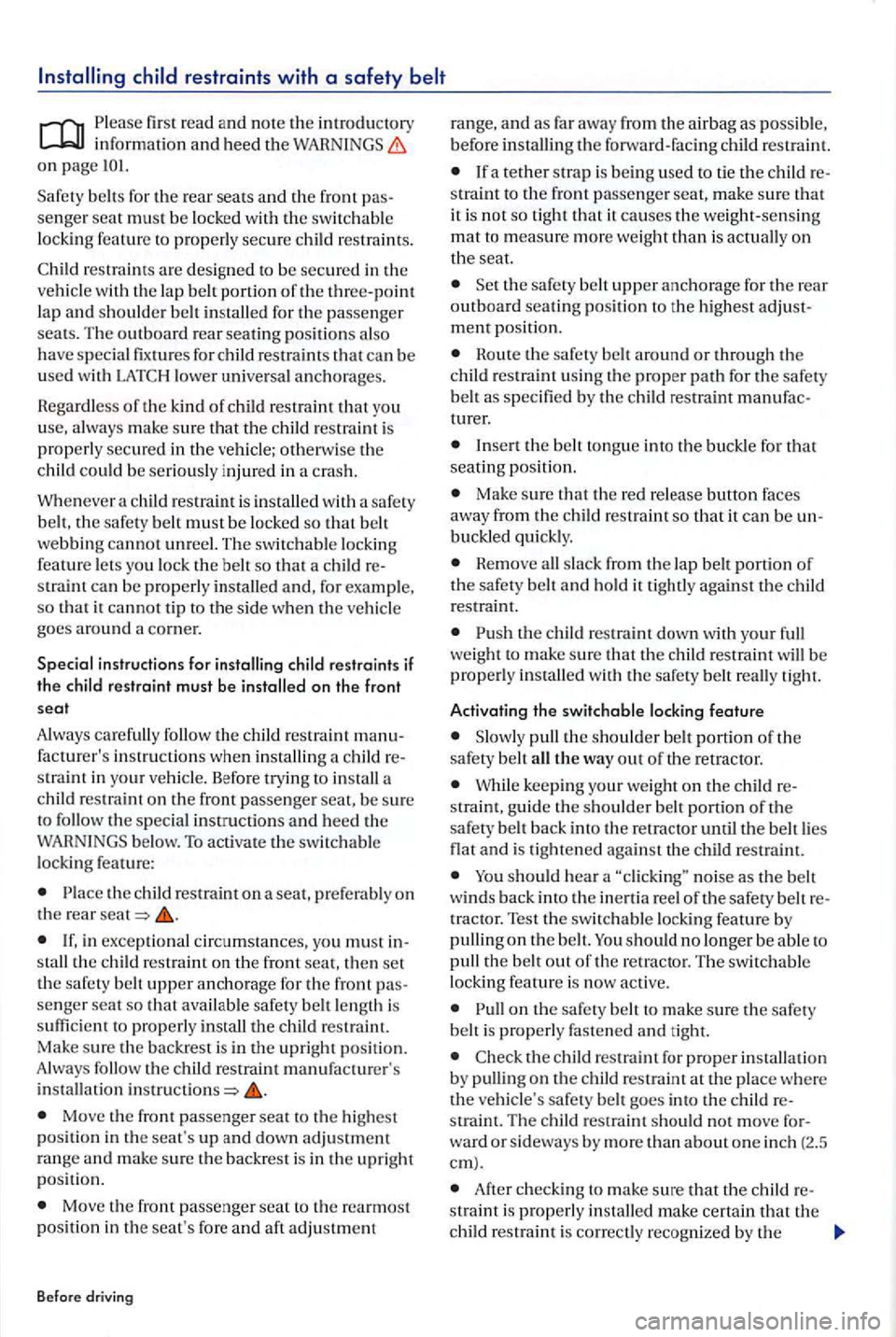
first read and no te the introductory informatio n an d heed th e WARNINGS on page
Safe ty belt s for the rear seats and the fro nt
crash .
W hen
ever a child res traint is in stalled wi th a sa fe ty
b elt , the safe ty be lt must be loc ked so that b elt webbin g cannot unreel. The sw itc hable lock ing feature lets yo u l ock the belt so that a chil d strain t can be properly in stalle d and, for example, so th a t it ca nnot tip to th e si de w hen the ve hicle goes around a corner.
on the front
s eal
A lways carefull y fo llow the c hild res tra in t factu rer's instruct ions when insta llin g a c hild str ain t in your ve hicl e. B efo re trying to a
c hild restr aint on the fro nt passenger seat, be sure
t o follow th e specia l instructio ns and heed th e WARNINGS below. To activa te the s witc h abl e
lock in g feature:
the chil d restraint on
in exce ptiona l c ircu mstances, you must
senger seat so that availa b le safe ty belt length is
s u ffici ent to properly install the child restraint. Make su re the backrest is in the upright p osition.
Always
Mo ve the fron t passenger seat to the high est posit io n in th e seat's up and down adjustment ra nge and m ake sure th e backres t is in the upright
posit io n.
Move the front passenger seat to the rearmost
positi on in th e seat's fo re a nd aft adjustment
B efo re drivin g
ra nge . and as far away fro m the ai rbag as possib le,
b e fore installing th e fonvar d-facing child restraint.
I f a te ther stra p is bein g used to t ie t he ch ild
t h e safety belt upper anchorage for the rear
o utboar d seatin g positi on to the hi ghest ment position.
R o ute the safety be lt around or through the
c hild res traint using th e proper p ath fo r the safe ty
b elt as specified by th e chil d res traint turer.
M ak e sure that the re d r ele ase button faces
away from the chil d res train t so th a t it can b e buckle d quick ly.
Remove all slack fro m the la p belt po rtion of the safety belt and ho ld it tightly against the chi ld
rest rai nt.
th e child restra in t down wit h your full
weight t o make su re that th e child restrai nt w ill be properly in stalled w ith the safety belt re all y tig ht.
Activating the switchable locking feature
pull the sh o uld er be lt portio n of th e
sa fety belt the way out of the retractor.
W hil e keep ing your weigh t o n the child strain! , guide th e sh o ulder belt portio n of th e
s a fety belt back into the retractor until th e belt lies flat a nd is tig htened aga inst the chil d restraint.
You sh o uld hea r a noise as th e belt
w inds back in to the in ert ia reel o f th e safety belt tractor. Test the sw itch a bl e lock ing feature by
pullin g on th e belt. s h o ul d no lo nge r be able to
pull the belt ou t of the retracto r. T he sw itc habl e
l ock ing feature is now active.
o n th e sa fe ty belt to make su re the safe ty
belt is prope rly fa stened a n d tight.
Check th e child res traint for p roper in stallatio n
by pullin g on th e c hild re straint at th e place where the ve hicle's safety belt goes into the ch ild straint. The child restrai nt sh ou ld no t m ove ward or sideways by more than a bout one in ch (2.5 e m).
After ch eck ing to make su re that th e chil d
Page 116 of 541
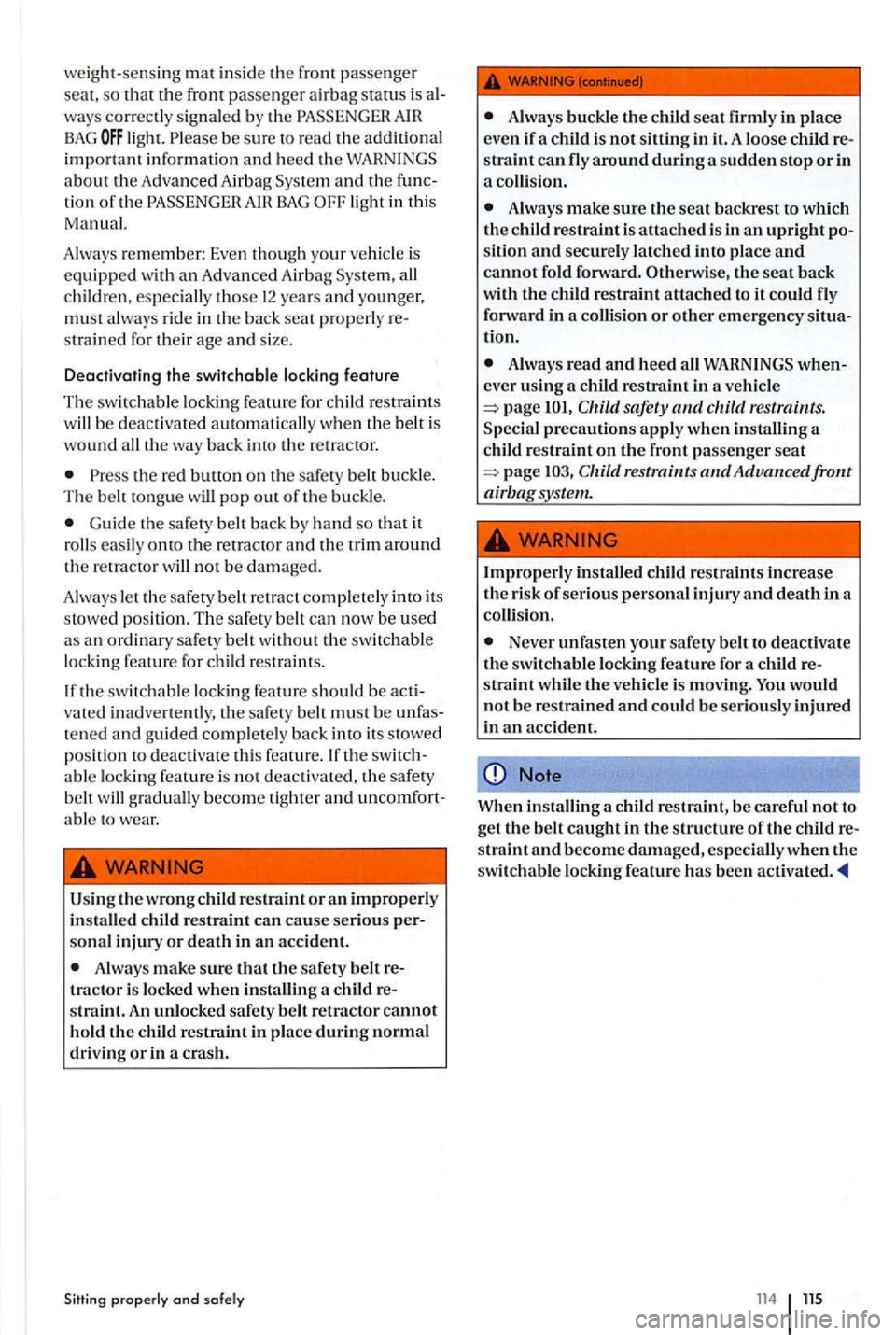
weight-sens ing mat in side th e fron t passenger
seat, so that the front passenger airbag status is ways correct ly signaled by th e AJR BAG light. be s ure to read th e add it io n al
im portant in form ation an d heed the WARN INGS abo ut Advanced Airb ag Sys te m and the
the red button on t he s afe ty belt buckle.
T he belt tong ue will pop out of th e buckle.
Guide th e sa fe ty belt bac k by hand so that it
roll s easily
va te d i nadve rten tly, the safety be lt mu st b e
lf the
able
A lways make sure th at th e safety belt tra cto r i s locke d when in stallin g a child straint. An unlocked safe ty belt re tractor cannot h o ld the c hild restraint in pla ce during normal driving or in a c rash.
S itting properly and s a fel y
Alw ays buckle the child seat A loose child stra int can fly around during a sudden sto p or in
a c olli sion.
A lways make sure the seat bac k res t to which
th e c hild restraint is a tta ched is in an upri ght siti on and securely la tc h ed int o place and cannot f old fonvar d. attached to it could fly fonvard in a c olli sion or o th er em erge ncy tion.
A lways read and heed all WARN INGS
page lOl , Child safety r es traints . S pec ia l precaution s apply when in sta llin g a
c hild restra int on the fro nt passe nger seat
Never unfa sten your safe ty belt to deactivate
th e switch a bl e lockin g feature for a child stra int whil e the vehicl e is moving. w oul d
n o t b e res trained and c o ul d be seriou sly inju red in an acci dent.
Note
When in stallin g a child restra int , b e care ful not to
g et th e belt caught in th e s tru cture of the child straint and become damaged, es peci all y when the sw itchabl e loc kin g feature has bee n activated.
114 115
Page 120 of 541
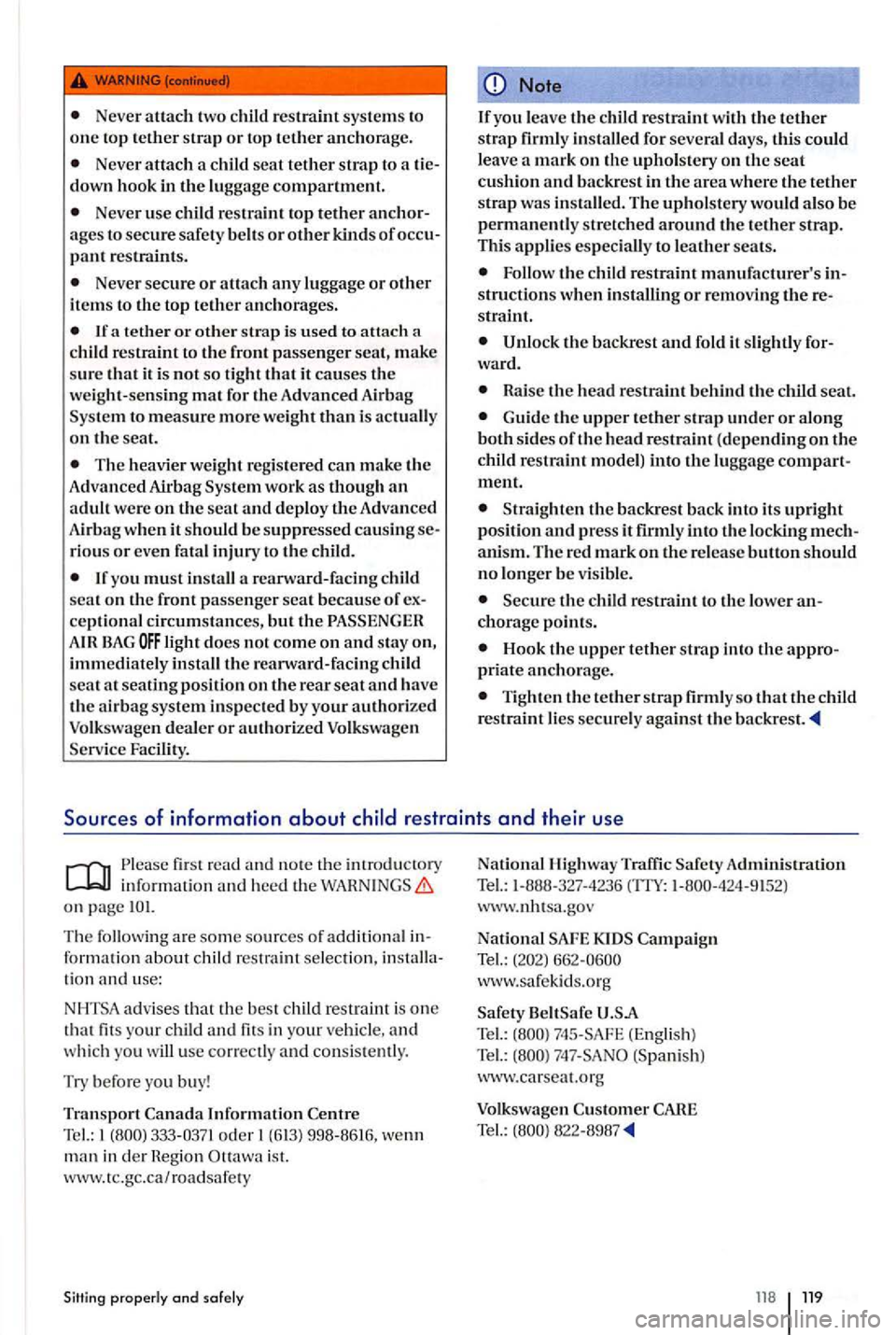
Never attach two child restraint sys te m s to one top tether strap or top tether anchorage.
Neve r attach a child seat tether strap to a
Never use ch ild restraint top tether
pant restraints.
Never secure or a ttach any luggage or other items to the top teth er anchorages.
a tether o r other strap is used to attach a
c hild restraint to the front passenger seat, make
sure tha t it is not so tight that it causes th e
we ight-se nsing mat for the A dvanced Airbag
T he heavier weight registe red can make the
Advanced Airbag work as though an
adult wer e on the se at and deploy the Adva nced Airbag when it should be s uppressed causing rious or eve n fa tal injury to the child .
If yo u must ins tall a rearward-facin g child seat o n th e fron t passenger seat because of ce ptional circumstances, but th e BAG
Facility .
Note
If you leave the child restraint with the tether strap firml y installed for seve ral days, this could leave a mark on th e upholste ry o n th e seat cu shion and backre st in the area w he re the teth er
s tra p was installed. The upho ls tery would also be permanen tly stretched around th e tether strap.
This applies especiall y to leather seats .
Follow the c hild restraint manufacturer's struction s w he n installing or remo vin g
Unlo ck th e backrest and fold it slightl y ward.
Gu ide th e upper tethe r strap under or along both s ides of the head restraint (depending on th e
c hild restraint model) into th e luggage
the backres t back into its upright position and press it firmly into th e locking
the c hild restraint to the lower chorage points.
priate anch orage.
Tighten the tether strap firml y so that th e child
restraint lies secure ly agai nst the
first read and no te th e introdu ctory infor mation and heed th e o n page
The followin g are som e sou rces of ad ditional formation about child restraint sele ct io n.
advises that th e best child restraint is one that fits your child and fits in your ve hicl e, and whic h you use correctly and co nsis te ntly.
Try before you buy!
Tran sport Tel.: I oder I (613) 998-86 16, wenn man in der Regio n ist.
www .tc.gc.ca/ roadsa fe ty
Sitting properly and safely
Nat io nal Hi gh way Traffic
www.nhtsa.gov
National Tel.:
B e lt
www.carseat.org
Volkswagen
118 119
Page 139 of 541
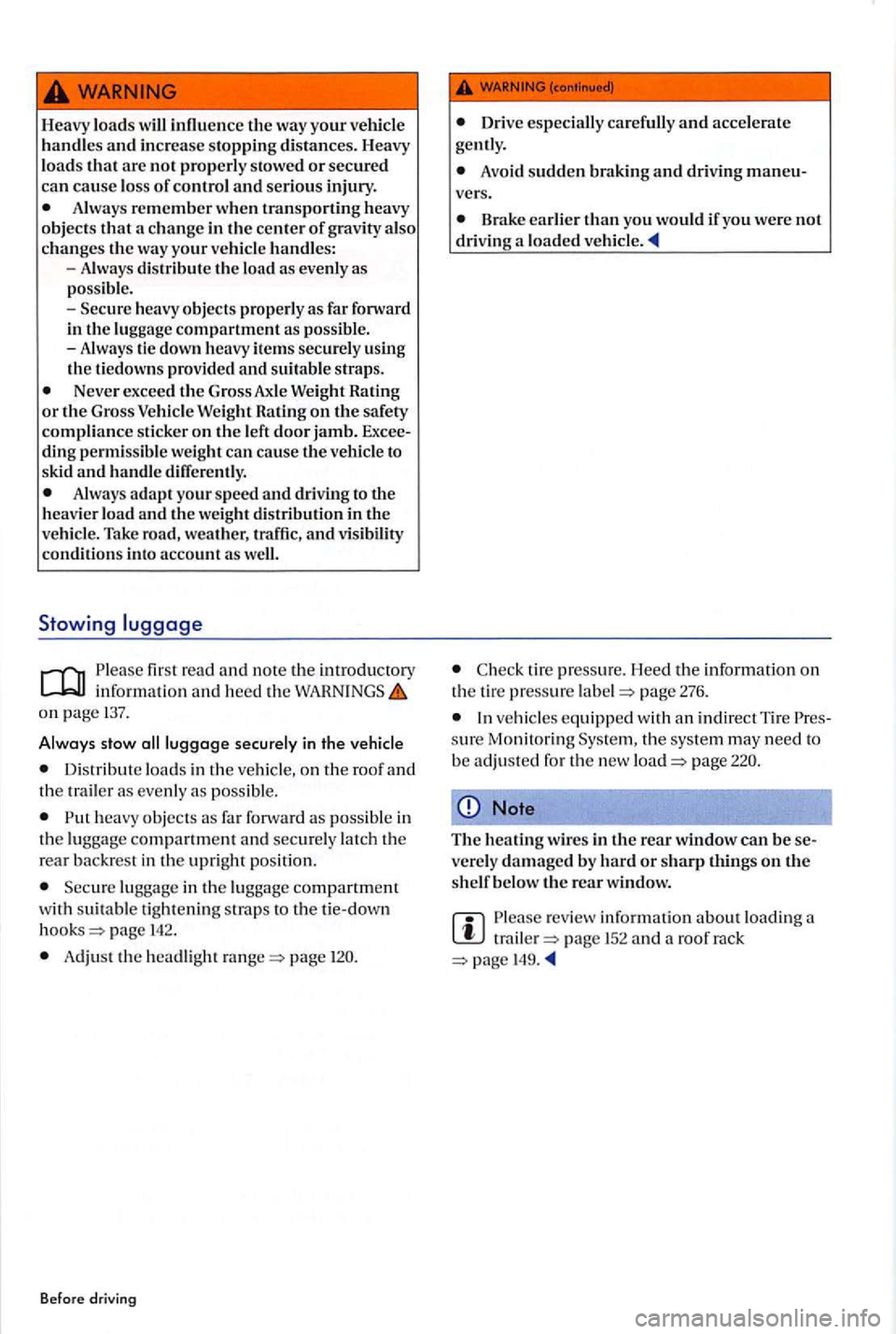
Heavy loads innuence th e way your vehicle handles and increa se stopping distances. Heavy
load s that arc not properly stowed or secured can cause los s of contro l and serious injury . Always remember when transporting heavy
objects that a change in the center of gravity also
changes the way your vehicle handles:
- Always dis tribute the load as evenly as
possib le. -heavy objects properly as far forward
in th e luggage compa rtme nt as possible.
- Always tie down heavy items secure ly using
th e tiedowns provided and suitable straps.
Never exceed th e Gross Axle Weight Rating or the Gross Vehicle Weight Rating on the safety compliance sticker on the left door jamb. Excee
ding permissible weight can cause the vehicle to
skid and handl e diff erentl
y.
Always adapt your speed and driving to th e
heavi er load and the we ight distribution in the
vehicl e. Take road, weathe r, and visibility
cond itions into acco unt as we ll.
Stowing
on page 137.
Always stow all luggage securely in the vehicle
Distribut e loads in the vehicle, on th e roof and the trail er as even ly as possible.
Secu re lu ggage in the luggag e compartment with suit able tightening strap s to the tie-down page 142.
Adjust the headli ght page
Before driving
Drive especia lly carefully and accelerate
gently.
Avoid sudden braking and driving maneu
ve rs.
Brake earlie r than yo u would if you were not driving a loaded
tire pressure. Heed the information on the tir e pressure page 276.
sure Monitor ing Syste m, the system may need to
be adjusted for the new page
CD Note
The heating wires in the rear window can be se
vere ly damaged by hard or sharp things on the sh elf below the rear window.
review inf ormation about loading a page 152 and a roof rack 149.
Page 141 of 541
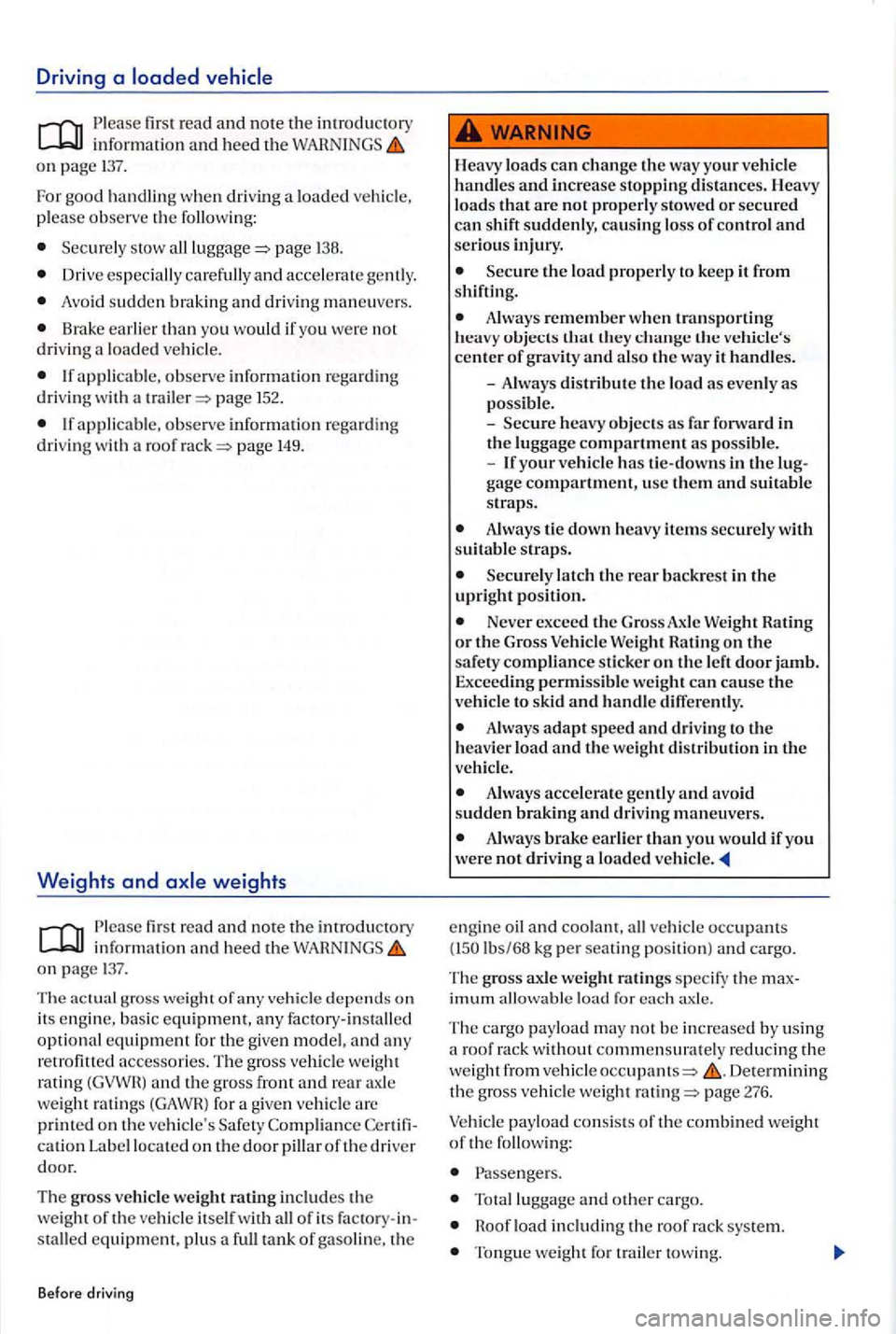
Driving a
first read and note the introductory informat io n and heed the WARNINGS on page 137.
F
or good h andli ng w he n driving a loa ded ve hicl e,
please observe the following:
Secure ly stow page 138.
Dr ive especially caref ully and acce le rate gently.
Avoid sudd en braking and driv ing man eu ve rs.
Brake earlier than you wou ld if yo u were not
drivi ng a loa ded vehicle.
page 152.
If applicabl e, observe information rega rdin g driv in g w ith roof page 149.
Weights and
firs t read and no te the introductory information and heed the WARNINGS o n page 137.
The gross weight of any vehicle depends on its en gin e, basic equipment, an y factory- in stalled
optional equipment for the given model, and any retrofitted accessories. T he gross vehicle weig ht
rat ing
catio n Label loca ted on the door pillar of the dri ver
door.
The gross vehicl e we ight rating includ es the
weight of the ve hicle itself w ith of its tank of gaso line, the
Before driving
lo ads can ch ange the way your vehicle
h andles and incre ase stop ping dista nces. loads that are not properly sto wed or secured can shift suddenly, causing loss of co ntrol and serio us injury.
the load prope rly to keep it from
shifting.
A lways remember w hen tra nsp o rtin g
h eavy obje cts th at th ey vehicle's cente r of gravity and also the way it handles.
- Always dis
tribute the load as eve nly as
possible. -h eavy obj ec ts as far forward in
th e luggage compartment as poss ible. -If your ve hicle has tie-downs in the
Always tie down heavy items securely wit h
s uitable straps.
Secure ly latch th e rear backrest in the upright position .
Never excee d th e Gross Axle Weight Ratin g
o r the Gross Weight Ratin g on the safe ty compliance sti cker on the left door jamb. Exceeding permissi b le weight ca n ca use the
ve hicl e to skid and ha ndl e diff erently.
Always adapt speed and drivi ng to th e
h ea vie r load and th e we ight di stribution in the vehicle.
Always accelerate gently and avo id
s udd en braking an d drivin g maneuvers.
Always brake ea rlier than yo u wo uld if you were not drivin g a loaded ve hicle .
engine oil and coola nt, lbs/68 kg per seatin g position ) and ca rgo .
T
he gross axle weig ht ra tin gs sp ec ify th e imum allowab le load for ax le.
The cargo payload may not be increased by using
a roof rack without commen surat ely reducing th e
we ig ht from vehicle Dete rmin ing
th e gross vehicle weight page 276.
pay load cons is ts of th e co mbin ed w eight of th e following:
Passe ngers.
Tota l luggage and othe r ca rgo .
Roof load including the roof rack system.
Tong ue weig ht for trailer towing.
Page 142 of 541
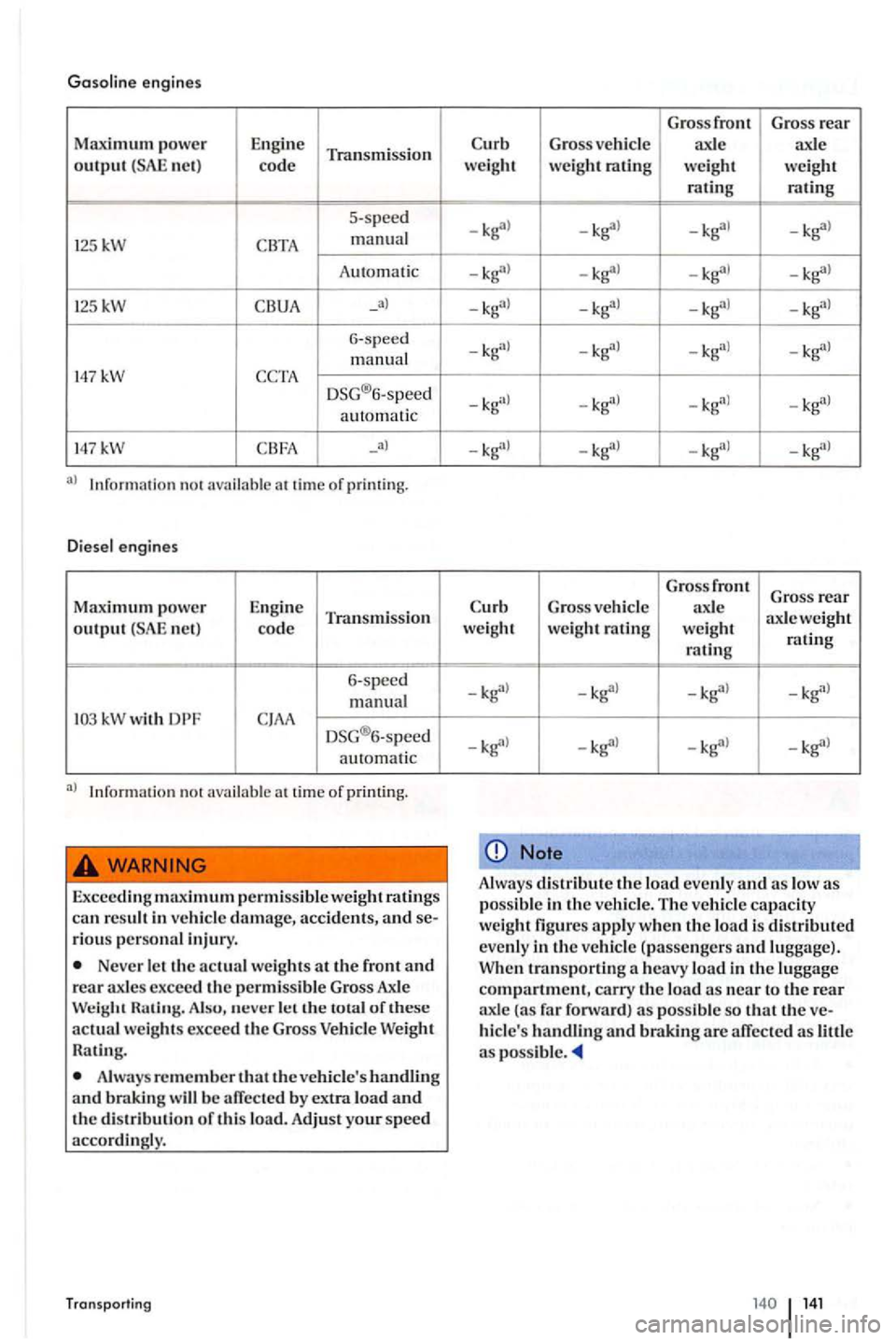
Gasoline engines
Maximum power Eng in e
Transmission output ne t)
code
5-speed
1 25kW
manual
A utomati c ---125kW _a)
6-speed
m anual
1
47kW cerA DSG® 6-speed autom atic
1 47kW
I nforma tio n not availab le
n et) code Transmission
6-speed manual
Exceed
ing m aximum permiss ibl e w eight ratin gs
ca n
Neve r let th e actual weights at the front and rea r ax les excee d th e permissible Gross Axle
remember that the ve hicle's handling and braking will be affected by extra load and the distributi on of thi s load. Adju st your s peed accordin gly.
Transporting
G ross front Gross rear
weig ht
weight ratin g weight weight
rating rating
--
---
-kg"l
Gross front
Gross rear G ross veh icle
axle
axle weight
weight weight rating weight
rating rating
-
Note
A
lwa ys distribute th e eve nly and as low as possib le in the vehicle. The ve hicl e capacity
weight figures appl y when the lo ad i s distributed
eve nly
141